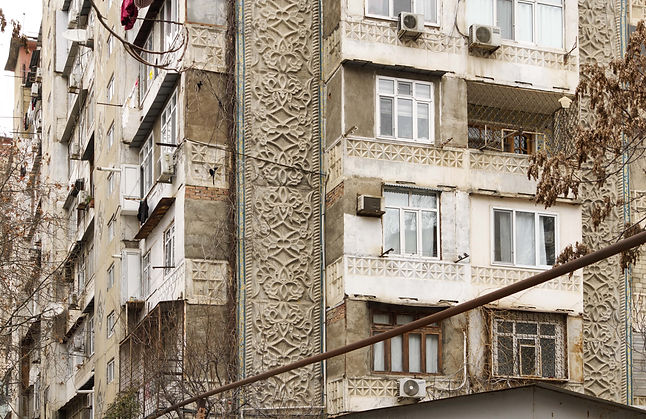Baku

Introduction
Baku, capital of Azerbaijan and larger than Yerevan and Tbilisi combined, is by far the most cosmopolitan city of the Caucasian states. It is a former Soviet regional capital turned into a contemporary metropolis on the rise where extreme wealth coexists with abject poverty. In Baku, pretentious Stalinist thoroughfares cut through run-down ghettos, and luxurious high-rises of dubious architectural quality cast their shadows on the severely dilapidated houses around as if to offer a constant reminder that the Soviet-backed value of equality was long gone.
The reason why Baku looks like a crossover between Moscow and Dubai is simple: Azerbaijan sits atop an immense source of oil that has been exploited first by the Russian Empire, then the Soviet Union, until independence and the completion in 2006 of the first technical infrastructures destined to export oil to new markets allowed Azerbaijan to exploit the resources for its own benefits. Not everyone benefited from this immense wealth source, and Baku's contemporary appearance bears the marks of a disparate society. But Baku cannot be reduced to flashy high-rises paid with oil money and shanty towns. It is a city shaped by its rich history. Several empires controlled the region throughout the ages, and each left a distinct imprint on the capital that can still be seen today. This includes the Soviet Union, which left a rarely-covered form of peculiar, albeit modest, local modernism.
Baku started as a small Persian town of narrow, dwindling streets, which have been preserved to this day. The Russian annexation of the region in the early 19th century and the beginning of oil exploitation turned the remote outpost into a modern city heavily influenced by European architectural trends. Russian Baku rapidly became the Little Paris of the Caucasus, and the subsequent integration of the town into the Soviet sphere (after a brief period of independence) did not lead to any significant architectural break from the past. Constructivism made modest headway in the capital (see the former Publishing House), but local architects heard the call to create "Socialist in content, National in form" and the first decades of Soviet rule were marked by a proliferation of imposing architectural projects of radically "national" appearance. However, this notorious call to give a national character to local architecture in the Soviet Union without forfeiting the Socialist content paradoxically found its most factually accurate iteration with the advent of prefabricated construction in the post-war years. The new "Mikrorayons" districts of the late 1960s to the mid-1980s comprising hundreds of prefabricated residential panel buildings, the same buildings that have achieved such a dubious reputation for their supposed lack of architectural value, became in Soviet Azerbaijan an unlikely field of experiment in national art. They were adorned with local patterns, "artistic slabs", and evocative window shapes recalling traditional Azeri art and architecture. The result is intriguing, to say the least, and can be best appreciated in the northern section of Mikrorayon 8, where the "art on concrete slab" was developed with remarkable creativity. Unfortunately, the appalling construction quality took its toll on the prefabricated structures, and most are now in terrible conditions. Besides the Mikrorayon and a few isolated examples, the Brezhnev era in Baku was not marked by a phenomenal breakthrough of modernism. With a preserved old town and a city center dominated by Russian and early Soviet construction, post-war modernism was largely pushed to the periphery, although a few noteworthy modernist buildings (such as the Central Railway Station) were built in the center. Furthermore, and to no one's surprise, Baku's modernist legacy became a convenient victim of the extensive urban redevelopment financed by oil money. In the last years, dozens of buildings were destroyed or "renovated", although to be fair, some "modernization" programs were actually of satisfying quality and went beyond the traditional lazy "white coating". For instance, the recent renovation of the Central Railway Station built in the 1970s successfully gave a modernist character to an initially conservative modernist shape. Unfortunately, the fate of the Karabagh Hotel nearby was grimmer: it was demolished alongside the stunning mosaic near its entrance.
Soviet-era public art pieces and propaganda slogans are surprisingly common in the capital of a country harboring such an ambiguous disposition toward its Soviet past. I was stunned to find on my first day the Communist slogan "Glory to Labor!" alongside a star-cum-hammer and sickle engraved on the cornice of a building overlooking the busiest square in Baku. A simple piece of propaganda with no peculiar artistic value, unlike the astonishing Soviet monument located a few kilometers away and dedicated to the renowned spy (and Baku native) Richard Sorge. This grim monument of exceptional evocative strength was assuredly one of the most thought-provoking pieces of public art in the Soviet Union. Fortunately, it has been preserved to this day. I have seen my fair share of Socialist-era monuments across the Eastern Bloc, but none came close to conveying the same feeling of sheer unease that penetrates the soul.
Baku's contemporary architecture deservedly achieved worldwide recognition for its boldness. The Heydar Aliyev Center (not to be mistaken with the Heydar Aliyev Palace) and the Carpet Museum, built following the 21st-century oil boom, received critical acclaim and now symbolize Baku's rebirth. But, the visual legacy of the second half of the 20th century has been curiously understudied even by the aficionados of the style, which makes Baku a relatively unknown destination in the closed world of Soviet Modernism enthusiasts. This, coupled with the numerous fascinating historical landmarks and diverse urban landscape, should convince you to consider Baku a prime architectural destination.